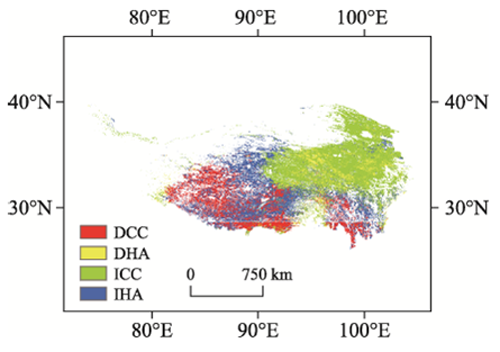Does Climate Change or Human Activity Dominate Alpine Grassland Change?
Both climatic change and human activities significantly influence carbon cycling, and ecosystem structure and function in terrestrial ecosystems. Quantifying the relative contributions of these two factors to ecosystem conditions is a great challenge. Alpine regions are more sensitive to climatic change and human activities than other regions throughout the world, and the Tibetan Plateau is an important and typical alpine region.
Alpine grasslands are used as pastures for livestock, and income from animal husbandry forms an important basis for local livelihoods on the Tibetan Plateau. Therefore, quantifying the causes of grassland change is of great significance to the economic development of the Tibetan Plateau.
Associate Professor FU Gang's team from the Institute of Geographic Sciences and Natural Resources Research of the Chinese Academy of Sciences found that gross primary production (GPP) can be used as an indicator to quantify ecosystem changes.
Because the terrestrial ecosystem model (TEM) model only reflects the influence of climate factors, the TEM GPP model was used to simulate potential gross primary productivity (GPPp) of alpine grasslands on the Qinghai-Tibet Plateau. The MODIS GPP (MOD17A2H) was used as actual gross primary productivity (GPPa) under conditions with a combination of human activities and climate change. Gross primary productivity (GPPh) affected only by human activities was calculated on the basis of GPPh = GPPp-GPPa.
Further studies showed that climate change and human activities accounted for 59.78% and 40.22%, respectively, of changes in actual gross primary productivity (Figure 1). The causes of actual gross primary production changes varied with elevation, region and grassland type. This indicates that the use of grassland classification management should be considered on the Tibetan Plateau.
 |
|
Figure 1: Spatial distribution of different drivers of alpine grassland GPP change (Image by Associate Prof. Fu Gang’s group) |
This work was published in the Journal of Resources and Ecology (Sun Wei, Li Meng, Wang Junhao, FU Gang*. 2019. Driving Mechanism of Gross Primary Production Changes and Implications for Grassland Management on the Tibetan Plateau. Journal of Resources and Ecology, 10(5): 472-480.
Download attachments: